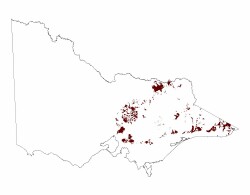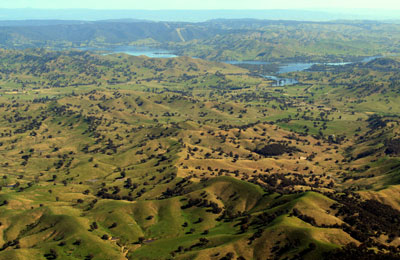1.4.5 Moderately dissected ridge and valley landscapes (Alexandra, Yea, Baranduda)
|
1. Eastern Uplands (EU) |  |
The Baranduda Range, between Yackandah Creek and Middle Creek is an example of this unit that extends to the west and then south towards Beechworth.
This Tier is much more prominent on the northern side of the Great Divide than to the south, where it can be recognised in quite limited sections of some valleys as they approach the Eastern Plains, e.g. the Avon River and its tributaries.

View of moderate ridge relief terrain with Lake Eildon in the mid distance.
Note sharp crests, consistent slope angles and gullying in foreground.
The vegetation, described mainly from the northern side of the Great Divide, is dry open forest dominated by Red Stringybark, Broad-leaf Peppermint, Long-leaf Box and Red Box. Forest Red Gum occurs throughout the unit, usually on soils that have a seasonally perched water-table.
The most common soils in the northern areas are poorly structured gradational soils (Kandosols) on the steeper slopes and red to yellow acid texture contrast soils (Kurosols) on the less steep slopes; alluvial/colluvial fans may have Kurosols or red or brown gradational soils (Dermosols).


